When working with data, you’ll often come across unnecessary whitespaces. These can be problematic in different scenarios, especially when filtering data or implementing machine learning models.
The extra spaces can affect readability, performance, and comparisons. This is where trimming a string comes in!
Trimming a string means removing the whitespace around some text.
Python offers built-in methods for trimming leading and trailing whitespaces and characters from strings. These methods are a part of the Python str class.
To trim a string in Python, you can use:
- The strip() method, which trims leading and trailing whitespace or specified characters from a given string.
- The lstrip() method, which trims whitespace only from the left side.
- The rstrip() method, which trims whitespace only from the right side.
We’ll explore the usage, syntax, and real-world examples of these methods.
Let’s get into it!

3 Basic Methods to Trim a Python String
In this section, we’ll discuss the 3 most basic methods to trim a Python string. Specifically, we’ll go over the following three built-in functions:
- Trimming a string with strip()
- Trimming a string with lstrip()
- Trimming a string with rstrip()
1. How to Trim a String with strip()
You can use the Python strip() method in Python to remove leading and trailing characters from a string.
By default, it removes white spaces such as spaces, tabs, and newlines. However, you can also specify which characters to remove by providing an argument to the method.
Let’s look at examples of both scenarios: when no argument is provided and when specific characters are provided.
Scenario 1: When No Argument is Provided
If you don’t provide any argument to the strip() method, it’ll remove only the whitespaces.
The following is an example of this scenario:
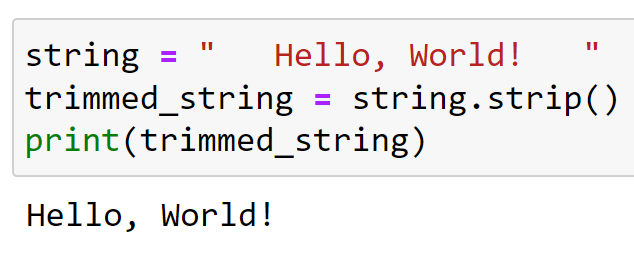
The function will remove all the whitespace characters from the start and end of the string.
Scenario 2: When Specific Characters Are Provided
You can provide a set of characters to the strip() method to remove them from the beginning and end of the string.
The method will remove characters as long as they exist in the provided set, regardless of their order in the set.
The following is an example of this scenario:
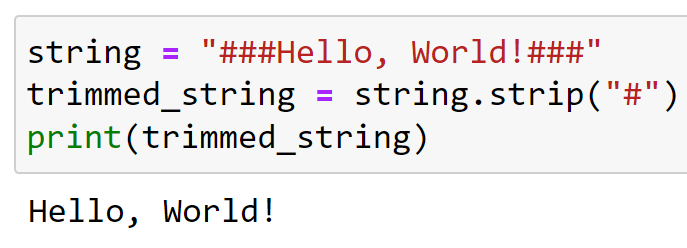
The above code trims characters that are specified in the function.
2. How to Trim a String With lstrip()
You can use the lstrip() method in Python to remove leading spaces and characters from a string.
By default, it removes leading whitespace characters such as spaces, tabs, and newlines.
However, you can also specify which characters to remove by providing an argument to the method.
Let’s look at examples of both scenarios: when no argument is provided and when specific characters are provided.
Scenario 1: When no Argument is Provided
If you don’t provide any argument to the lstrip() method, it will remove leading whitespaces.
The following example demonstrates this scenario:
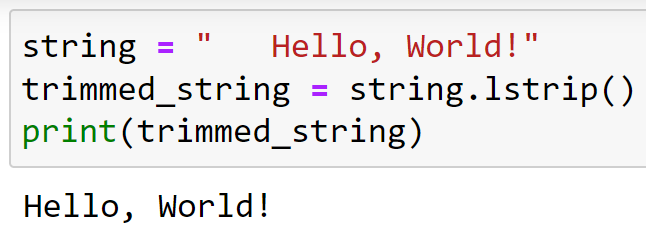
The function will remove only whitespaces from the left of the input string.
Scenario 2: When Specific Characters Are Provided
You can provide a set of characters to the lstrip() method to remove them from the beginning of the string.
The following is an example of this scenario:

In the example above, we specified the # character to be removed, so lstrip() will remove the leading # characters from the original string.
3. How to Trim String Using rstrip()
The rstrip() method is one of Python’s built-in methods that’ll remove whitespaces from the end of a string. You can either provide an argument to the function or leave it on its default parameters.
Scenario 1: When No Argument is Provided
If you don’t provide any argument to the rstrip() method, it’ll remove whitespaces at the end of the string.
The following is an example of this scenario:
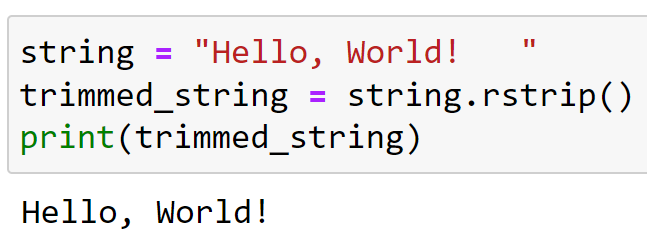
Scenario 2: When Specific Characters Are Provided
You can provide a set of characters to the rstrip() method to remove them from the end of the string.
The following is an example of this scenario:
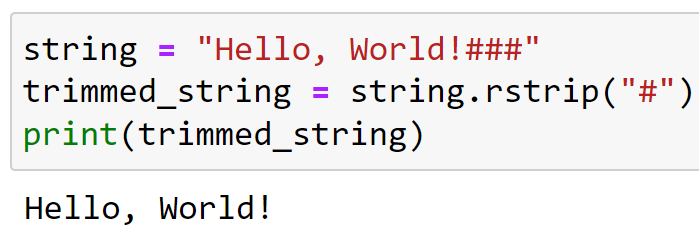
In the example above, we specified the # character to be removed, so rstrip() removed the trailing # characters as you can see in the output string.
3 Alternatives of Basic Trimming Methods in Python
In this section, we’ll explore 3 alternative methods of trimming a string in Python.
Specifically, we’ll go over the following:
- Using re (Regular Expression) module
- Using string slicing
- Using list comprehension
The alternatives can function more robustly in certain scenarios, especially the regular expression module.

1. How to Trim a String Using re module
The re module in Python provides regular expression matching operations. If you need more advanced string trimming capabilities, especially involving patterns, the re module is very handy.
With re module, you can:
- Trim whitespaces
- Trim characters
1. Trimming Whitespaces With re module
Whitespace includes all Unicode whitespace characters, such as tabs ( \t ), spaces, carriage returns ( \r ), and newlines ( ).
To trim whitespaces from a string, you can use the re.sub() function.
The following is an example of this scenario:
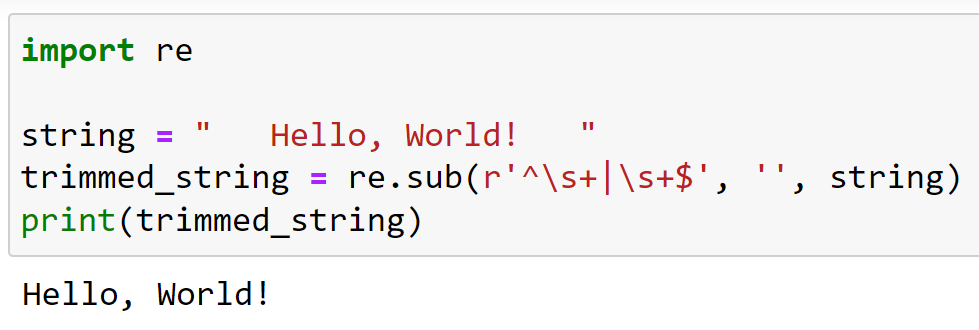
In the regex pattern ^\s+|\s+$:
- ^\s+ matches one or more whitespace characters at the beginning of the string.
- |\s+$ matches one or more whitespace characters at the end of the string.
2. Trimming Characters With re module
The re module can also trim specific characters from the beginning and end of a string.
The following is an example of this scenario:
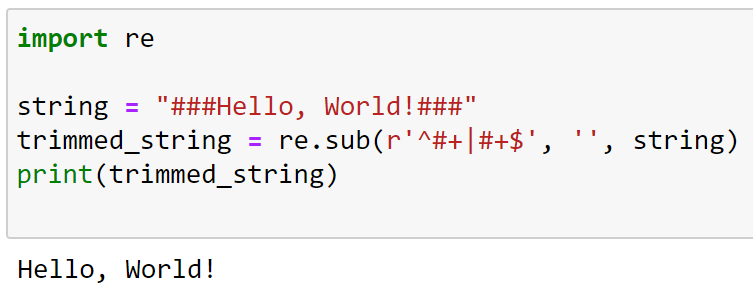
Here, the regex pattern ^#+|#+$ trims the # character:
- ^#+ matches one or more # characters at the start of the string.
- |#+$ matches one or more # characters at the end of the string.
2. How to Trim a String Using String Slicing
Though not as efficient or clear as the strip() method, you can trim a string by slicing it as well.
The following is an example of this method:
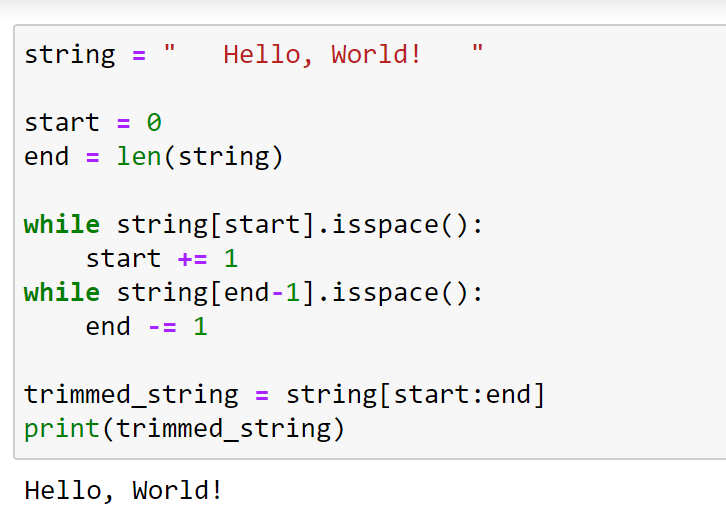
3. How to Trim String Using List Comprehension
Using list comprehension for trimming a string is not a conventional way, but you can break the string into individual lines and strip each line.
After stripping, you can join them back together.
The following is an example of trimming string using list comprehension:

This method is more applicable when you have a multi-line string and want to strip each line individually.
If you’d like to learn more about text handling in Python, check out the following video:
Final Thoughts
String trimming in Python is a fundamental tool for managing messy data or inconsistent input.
By understanding how to precisely refine and shape your strings, you enable yourself to handle data more efficiently and make your programs more resilient to unexpected inputs.
It’s these small details, like string trimming, that differentiate a good programmer from a great one.
The techniques discussed in this article will help you improve the quality of your code and handle inconsistent data more easily. Happy coding!
Frequently Asked Questions
In this section, you’ll find some frequently asked questions you may have when trimming strings in Python.

How to remove extra spaces between words?
You can use the split() and join() methods to remove extra spaces between words in a Python string.
First, split the string into words using split() and then join the words back together using the join() method:
text = "This is an example text"
corrected_text = " ".join(text.split())
How to trim leading and trailing spaces?
To trim whitespaces, you can use the strip() method.
This method will remove all whitespaces from both ends of the string:
text = " Hello, world! "
trimmed_text = text.strip()
How to delete newlines from a string?
To delete newline characters from a string, you can use the replace() method:
text_with_newlines = "Hello\nWorld\n"
new_text = text_with_newlines.replace('\n', '')
How to use the lstrip() and rstrip() effectively?
You can use the lstrip() method to remove leading whitespaces and rstrip() to remove trailing whitespaces:
text = " Hello, world! "
left_trimmed = text.lstrip()
right_trimmed = text.rstrip()
How to remove whitespace from list elements?
To remove whitespaces from a list of strings, use a list comprehension that applies the strip() method to each element:
strings_list = [" Alp ", " Ber ", " Sig "]
trimmed_list = [s.strip() for s in strings_list]








